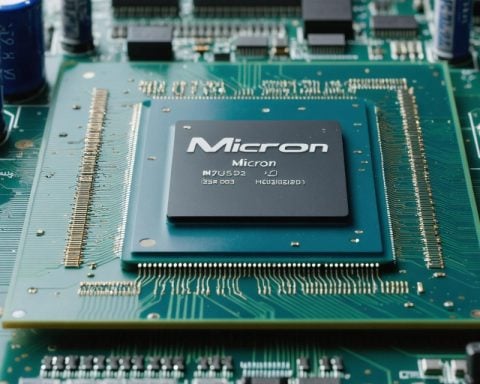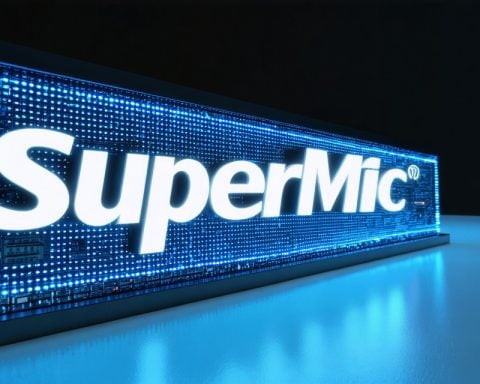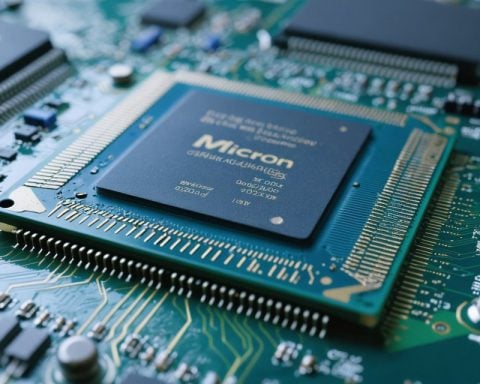- Samsung’s stock is experiencing significant volatility, primarily affected by foreign investor sell-offs.
- The company has reduced its fourth-quarter financial projections due to issues in the memory division.
- Challenges in the memory division arise from declining shipments and reduced semiconductor prices.
- Leadership is emphasizing financial prudence, with measures to stabilize against stock devaluation.
- Samsung is focusing on innovation in areas like AI chips and 5G to drive future growth and maintain competitiveness.
Samsung Electronics, a titan in the global technology arena, finds itself in a whirlwind of market unrest. Recent assessments bring to light the pressing challenges that impact its stock valuations and strategic positioning.
Volatility in Stock Movement: Samsung’s stocks have been on a rollercoaster, fluctuating tightly between 50,000 and 55,000 won. This instability is fueled by a noticeable sell-off from foreign investors, who have divested throughout December, intensifying downward market pressure.
A Downshift in Financial Projections: The company has slashed its fourth-quarter estimates, pointing to a decrease from 92 trillion won in sales and 15 trillion won in operating profits to 88 trillion won in sales and 10 trillion won in profit. The undercurrents of this shift lie primarily in the troubled memory division, where sales are anticipated to keep sinking.
Memory Division Woes: Dwindling shipments and falling semiconductor prices are areas of concern. Despite the technological allure of high bandwidth memory, its financial weight is unexpectedly light. This necessitates a recalibration of Samsung’s product strategy.
Leadership Strategies: Prominent figures within Samsung, such as Lee Bu-jin of Hotel Shilla, have taken measures to hedge against plummeting stock values by renewing collateral loan agreements. This move underscores a critical need to maintain fiscal prudence amid constraint.
Future Directions and Innovations: As Samsung navigates these challenges, innovation remains its beacon. Enhanced focus on cutting-edge technologies, from AI chips to 5G, could herald new growth avenues. By realigning its strategic goals, Samsung could fortify its competitive edge, ensuring its resilience in the face of evolving global challenges.
Samsung stands at a pivotal junction, pressured yet poised for transformative strides. The company’s legacy of leading innovation might just be its key to securing a brighter horizon.
Samsung’s Pivotal Stride: Navigating Challenges and Crafting Futures
Pros and Cons of Samsung’s Current Market Position
Samsung Electronics is facing a volatile market ecosystem, challenging its financial stability and strategic movement. This instability offers both opportunities and drawbacks.
Pros:
– Technological Innovation: Samsung’s commitment to R&D in AI and 5G provides new growth trajectories and could position the company as a leader in emerging tech trends.
– Global Presence: As a heavyweight in electronics, Samsung has the infrastructure and distribution channels to swiftly capitalize on innovations.
Cons:
– Financial Turbulence: The memory division’s ongoing struggles and decreased financial forecasts weaken investor confidence.
– Foreign Investor Impact: Significant sell-offs from foreign investors exacerbate stock price volatility, affecting short-term financial stability.
Market Forecast and Trends
Despite current setbacks, market analysts predict that Samsung’s robust R&D investment and strategic pivots may yield positive outcomes:
– AI and 5G Technologies: These sectors are anticipated to boom. Samsung’s initiatives in these areas might propel them as leaders in the tech sector.
– Sustainability Drives: Increasing emphasis on eco-friendly electronics could reinforce Samsung’s brand as a responsible, future-focused company.
Security and Sustainability
Samsung’s new initiatives are expected to pay dividends in terms of security and sustainability:
– Enhanced Security Measures: With an eye on cybersecurity advancements, Samsung is integrating better security protocols in its products, instilling confidence for users and investors alike.
– Sustainable Practices: Commitment to reducing carbon footprints and advancing sustainability in production practices aligns with global environmental goals.
Related Questions
1. What are the key challenges Samsung faces in the semiconductor industry?
Samsung is experiencing pressures due to declining semiconductor prices and demand. The fluctuating market has resulted in lower-than-expected financial projections, which have further impacted stock valuation and investor confidence.
2. How can Samsung leverage innovation to overcome these challenges?
Investing in cutting-edge technologies like AI and 5G can diversify Samsung’s revenue streams and potentially offset losses in traditional sectors such as memory. Strategic collaborations and partnerships also offer pathways to supplement innovation efforts.
3. What strategies are in place to stabilize stock prices amidst volatile market conditions?
Samsung is actively renewing collateral loan agreements to hedge against stock depreciation, demonstrating a proactive approach to financial management. In tandem, enhancing transparency and communication with investors can help stabilize market perceptions.
Suggested Links
– Samsung























